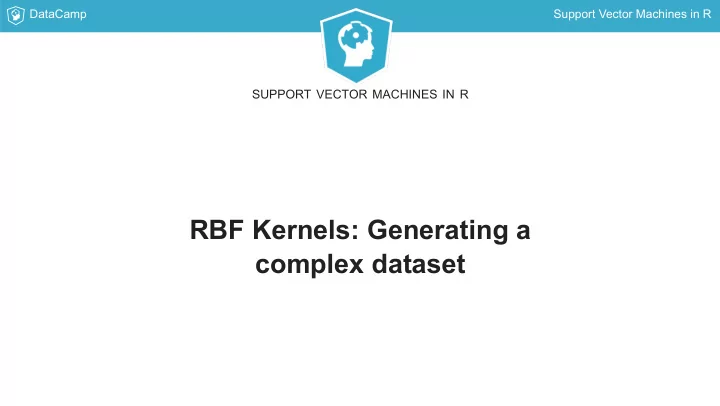

DataCamp Support Vector Machines in R SUPPORT VECTOR MACHINES IN R RBF Kernels: Generating a complex dataset
DataCamp Support Vector Machines in R A bit about RBF Kernels Highly flexible kernel. Can fit complex decision boundaries. Commonly used in practice.
DataCamp Support Vector Machines in R Generate a complex dataset 600 points (x1,x2) x1 and x2 distributed differently n <- 600 set.seed(42) df <- data.frame(x1 = rnorm(n, mean = -0.5, sd = 1), x2 = runif(n, min = -1, max = 1))
DataCamp Support Vector Machines in R Generate boundary Boundary consists of two equi-radial circles with a single point in common. #set radius and centers radius <- 0.7 radius_squared <- radius^2 center_1 <- c(-0.7,0) center_2 <- c(0.7,0) #classify points df$y <- factor(ifelse( (df$x1-center_1[1])^2 + (df$x2-center_1[2])^2 < radius_squared| (df$x1-center_2[1])^2 + (df$x2-center_2[2])^2 < radius_squared, -1,1), levels = c(-1,1))
DataCamp Support Vector Machines in R Visualizing the dataset Visualize the dataset using ggplot; distinguish classes by color library(ggplot2) p <- ggplot(data = df, aes(x = x1, y = x2, color = y)) + geom_point() + guides(color = FALSE) + scale_color_manual(values = c("red","blue")) p
DataCamp Support Vector Machines in R
DataCamp Support Vector Machines in R Code to visualize the boundary #function to generate points on a circle circle <- function(x1_center, x2_center, r, npoint = 100){ theta <- seq(0,2*pi, length.out = npoint) x1_circ <- x1_center + r * cos(theta) x2_circ <- x2_center + r * sin(theta) return(data.frame(x1c = x1_circ, x2c = x2_circ)) } # generate boundary and plot it boundary_1 <- circle(x1_center = center_1[1], x2_center = center_1[2], r = radius) p <- p + geom_path(data = boundary_1, aes(x = x1c, y = x2c), inherit.aes = FALSE) boundary_2 <- circle(x1_center = center_2[1], x2_center = center_2[2], r = radius) p <- p + geom_path(data = boundary_2, aes(x = x1c, y = x2c), inherit.aes = FALSE) p
DataCamp Support Vector Machines in R
DataCamp Support Vector Machines in R SUPPORT VECTOR MACHINES IN R Time to practice!
DataCamp Support Vector Machines in R SUPPORT VECTOR MACHINES IN R Motivating the RBF kernel
DataCamp Support Vector Machines in R Quadratic kernel (default parameters) Partition data into test/train (not shown) Use degree 2 polynomial kernel (default params) svm_model<- svm(y ~ ., data = trainset, type = "C-classification", kernel = "polynomial", degree = 2) svm_model .... Number of Support Vectors: 204 #predictions .... pred_test <- predict(svm_model, testset) mean(pred_test==testset$y) [1] 0.8666667 #plot plot(svm_model, trainset)
DataCamp Support Vector Machines in R
DataCamp Support Vector Machines in R Try higher degree polynomial Rule out odd degrees -3,5,9 etc. Try degree 4 svm_model<- svm(y ~ ., data = trainset, type = "C-classification", kernel = "polynomial", degree = 4) svm_model .............. Number of Support Vectors: 203 ... pred_test <- predict(svm_model, testset) mean(pred_test==testset$y) [1] 0.8583333 #plot plot(svm_model, trainset
DataCamp Support Vector Machines in R
DataCamp Support Vector Machines in R Another approach Heuristic : points close to each other have the same classification: Akin to K-Nearest Neighbors algorithm. For a given point in the dataset, say X1 =(a,b): The kernel should have a maximum at (a,b) Should decay as one moves away from (a,b) The rate of decay should be the same in all directions The rate of decay should be tunable A simple function with this property is exp(-gamma*r) , where r is the distance between X1 and any other point X
DataCamp Support Vector Machines in R How does the RBF kernel vary with gamma (code) #rbf function rbf <- function(r, gamma) exp(-gamma*r) ggplot(data.frame(r = c(-0, 10)), aes(r))+ stat_function(fun = rbf, args = list(gamma = 0.2), aes(color = "0.2")) + stat_function(fun = rbf, args = list(gamma = 0.4), aes(color = "0.4")) + stat_function(fun = rbf, args = list(gamma = 0.6), aes(color = "0.6")) + stat_function(fun = rbf, args = list(gamma = 0.8), aes(color = "0.8")) + stat_function(fun = rbf, args = list(gamma = 1), aes(color = "1")) + stat_function(fun = rbf, args = list(gamma = 2), aes(color = "2"))+ scale_color_manual("gamma", values = c("red","orange","yellow", "green","blue","violet")) + ggtitle("Radial basis function (gamma=0.2 to 2)")
DataCamp Support Vector Machines in R
DataCamp Support Vector Machines in R SUPPORT VECTOR MACHINES IN R Time to practice!
DataCamp Support Vector Machines in R SUPPORT VECTOR MACHINES IN R The RBF Kernel
DataCamp Support Vector Machines in R RBF Kernel in a nutshell Decreasing function of distance between two points in dataset. Simulates k-NN algorithm.
DataCamp Support Vector Machines in R
DataCamp Support Vector Machines in R Building an SVM using the RBF kernel Build RBF kernel SVM for complex dataset svm_model<- svm(y ~ ., data = trainset, type = "C-classification", kernel = "radial") Calculate training/test accuracy and plot against training dataset. pred_train <- predict(svm_model, trainset) mean(pred_train==trainset$y) [1] 0.93125 pred_test <- predict(svm_model, testset) mean(pred_test==testset$y) [1] 0.9416667 #plot decision boundary plot(svm_model, trainset)
DataCamp Support Vector Machines in R
DataCamp Support Vector Machines in R Refining the decision boundary Tune gamma and cost using tune.svm() #tune parameters tune_out <- tune.svm(x = trainset[,-3], y = trainset[,3], gamma = 5*10^(-2:2), cost = c(0.01,0.1,1,10,100), type = "C-classification", kernel = "radial") Print best parameters #print best values of cost and gamma tune_out$best.parameters$cost [1] 1 tune_out$best.parameters$gamma [1] 5
DataCamp Support Vector Machines in R The tuned model Build tuned model using best.parameters svm_model <- svm(y~ ., data=trainset, type="C-classification", kernel="radial", cost=tune_out$best.parameters$cost, gamma=tune_out$best.parameters$gamma) Calculate test accuracy mean(pred_test==testset$y) [1] 0.95 plot decision boundary plot(svm_model, trainset)
DataCamp Support Vector Machines in R
DataCamp Support Vector Machines in R SUPPORT VECTOR MACHINES IN R Time to practice!
Recommend
More recommend